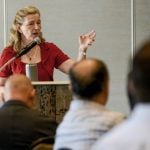Bruce Coulman probably doesn’t tell a lot of people how old he is, but in his profession age is becoming an issue.
The head of plant sciences at the University of Saskatchewan is 60.
He’s one of six forage researchers at public institutions in Canada. Five of them are at least his age or older.
The researchers are asking questions as they move closer to retirement – one of them has in fact retired twice only to return.
Read Also

Agriculture ministers agree to AgriStability changes
federal government proposed several months ago to increase the compensation rate from 80 to 90 per cent and double the maximum payment from $3 million to $6 million
“Will our organizations replace us?” Coulman said. “And secondly, can we find qualified people to replace us?”
Many of the younger researchers coming up through the universities are interested in molecular fields rather than the type of work that Coulman and his peers are doing.
A study by Strategic Vision Consulting Ltd. for the Canadian Cattlemen’s Association two years ago found that fewer students see plant breeding and agricultural research as an attractive option.
“In order to attract new students to these fields of study, Canada needs to fund new career research positions in agriculture in anticipation of future retirements,” the study said.
Coulman said the industry has to do a better job of recruiting students to graduate programs if the researchers are to be replaced. It’s more difficult to recruit local students than it is to find international candidates, he added.
He said no Canadian forage varieties will be developed if all six researchers retire and aren’t replaced.
Producers and seed companies would have to buy from the United States or Europe and those varieties don’t always perform as well in Canada.
“I think that would be too bad,” Coulman said. “Our varieties are picked up by the seed industry. There is a demand.”
One of public research’s greatest accomplishments is the development of meadow brome in the 1980s. It is now the number one pasture grass in Canada, Coulman said.
Obtaining funding for forage research is a challenge. Coulman said he had a few lean years with ADF funding. A little check-off money is sometimes available.
The forage seed industry isn’t usually a good funding source because it is fragmented into smaller sectors according to use and none of them have critical mass. Forage seed companies aren’t likely to pick up the slack if public research disappears, he added.
“The companies that sell most of the forage seed are not large companies.”
Only Pickseed in Ontario maintains a small breeding program.

















